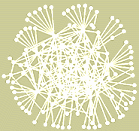
|
 |
|
Network topology in epidemic spread and control (in collaboration with dr A. Kleczkowski , Epidemiology and Modelling Group, Department of Plant Sciences, University of Cambridge) |

|
One of outstanding problems in modelling infectious disease spread is the role of individual susceptibility to the disease in the population studied. Susceptibility varies across the population, and a single particularly resistive individual in a chain of individuals connected by social, or trophic, or sexual relations, can effectively stop a disease from spreading. This effect, in turn, may be largely nullified if there is a "short cut" (an additional link between distant individuals) by means of which the disease can bypass a resistive spot.
Another key aspect of epidemic spread modelling is the structure and topology of the network connecting the individuals. Recently, networks of the small world type are being used for modelling an epidemic spread. This type of network topology seems to work fine for plant populations, but as other studies indicate, social networks through which an epidemic can spread, are of another type: scale-free, with "hubs" centered at particularly socially active individuals and other individuals being connected to the rest of the group by a smaller number of links.